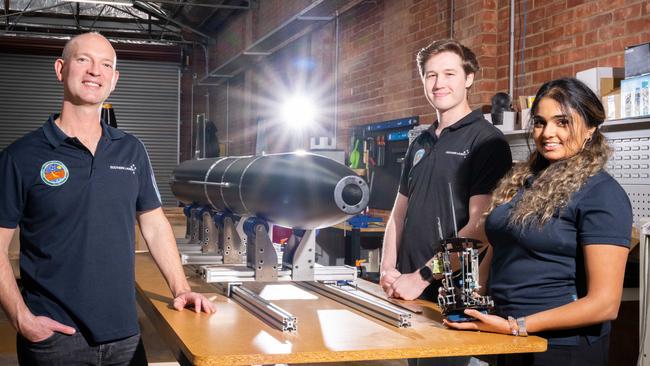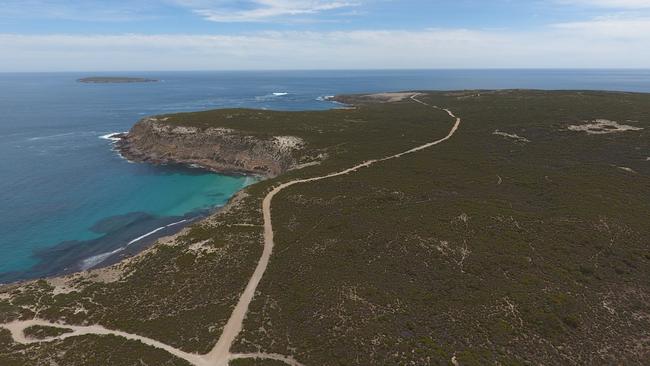Southern Launch eyes maiden launch from Whalers Way spaceport site
Southern Launch is forging ahead with plans to make Eyre Peninsula the country’s space capital, eyeing a maiden launch from its flagship spaceport next year.
Southern Launch is forging ahead with plans to make the Eyre Peninsula the space capital of Australia, eyeing a maiden orbital launch from its flagship spaceport site next year.
The company is currently seeking various local, state and federal approvals for its two launch sites - the Koonibba test range 40km north-west of Ceduna and the Whalers Way orbital launch complex at the southern tip of the peninsula.
Approvals would support a multi-million dollar investment in permanent infrastructure at both sites at a time when launch facilities around the world are at capacity.
Southern Launch chief executive Lloyd Damp said contracts were already in place with users at Whalers Way, including local rocket company ATSpace.
“The (Whalers Way) site will require about $40m to $45m worth of investment,” he said.
“We’re currently working out the infrastructure requirements with the customers that we’ve already got signed up for the site, so it’s a very exciting stage.
“The first orbital launch, I’m hoping, will take place mid-to-late next year, pending all approvals.
“There’s massive pressure on launch sites around the world at the moment - they’re fully congested. So there is huge potential for Whalers Way and South Australia to capitalise on that.”

Southern Launch was established in 2017 and is backed by a group of high net worth South Australian and interstate families.
The company secured $4.95m in federal funding last year to go towards development at Whalers Way and to also support the company’s rocket manufacturing ambitions.
That was followed earlier this year with a further $4.5m in funding to go towards the Koonibba site, which it is developing in a partnership with the local Koonibba Community Aboriginal Corporation.
Construction at Koonibba is expected to commence by the end of this year, and will include a First Nations observatory. The project will be delivered in stages, with key components of the facility to be ready for launch campaigns with the German Aerospace Centre (DLR) next year.
While some space industry leaders have voiced concern about the federal government’s decision to slash $77m in funding from the industry in last month’s budget, including $32.3m previously earmarked for co-investment into spaceports, Mr Damp said Southern Launch was well resourced to execute on its vision.
“We’ve never relied on grant funding - we’ve always seen grants as a very helpful leg up, you could say, but not ever part of our core business model,” he said.

“And we’ve always far preferred contracts, which help us create an enduring capability and demonstrate a market that’s a global market for what it is we’re doing.”
A road map recently compiled by a group of space and geospatial experts recently warned Australia was slipping behind its target for the space industry to triple in size to $12bn and 30,000 jobs by 2030.
But Mr Damp said Australia had several natural advantages, and a recent technology safeguard agreement with the US was a potential game-changer for the industry.
The TSA, which had been in negotiation since October 2021, will enable the transfer of US space technology, including rockets and satellites, to be launched from Australia.
“It unlocks the ability for American rocket companies to come to Australia,” Mr Damp said.
“And if they’re waiting months and years to get onto a US launch pad, but they can very easily come to Australia, we become a destination of choice for these companies, their technology and the benefits.
“Australia is very unique in that we are so large and close to the equator, and we can potentially service all of these different orbits from different locations around the country.
“So there’s a great opportunity for Australia to become that single nexus, that single focus globally.”
For the Eyre Peninsula, Southern Launch predicts that the Koonibba observatory and launch facility will contribute more than $500,000 annually to the local economy.
But the benefits could run much deeper, according to Mr Damp, given the potential flow on effect to other industries.
“The launch site is the natural central point for a space industry so we’re incredibly proud that we can be that anchor that the industry is built upon,” he said.
“And we love that there’s a connecting web of industries building off of it. There’s an opportunity for hi-tech manufacturing in the region, and there’s also the traditional manufacturing that we’re supporting, like Ferretti and Hydroil becoming a part of the space industry and applying their skills in new and different ways.
“And the other point we’re incredibly proud of is the space industry becoming a supplementary industry to agriculture in the region.
“It becomes an industry that’s not reliant on the weather, where there’s good years and bad years - it’s just this steady opportunity that will be there for the region.”
Local manufacturing and engineering companies Ferretti and Hydroil are currently manufacturing a mobile launch rail – a transportable rocket launcher – which will be used at Southern Launch’s two sites.
The company is currently recruiting for several roles including a range operations manager, avionics engineers, launch engineers, civil engineers and support roles in administration and IT management.
Mr Damp said the company was receiving significant interest from interstate candidates, including launch engineer Matthew Willson and avionics engineer Farisha Jamal who both recently relocated from Sydney.





To join the conversation, please log in. Don't have an account? Register
Join the conversation, you are commenting as Logout